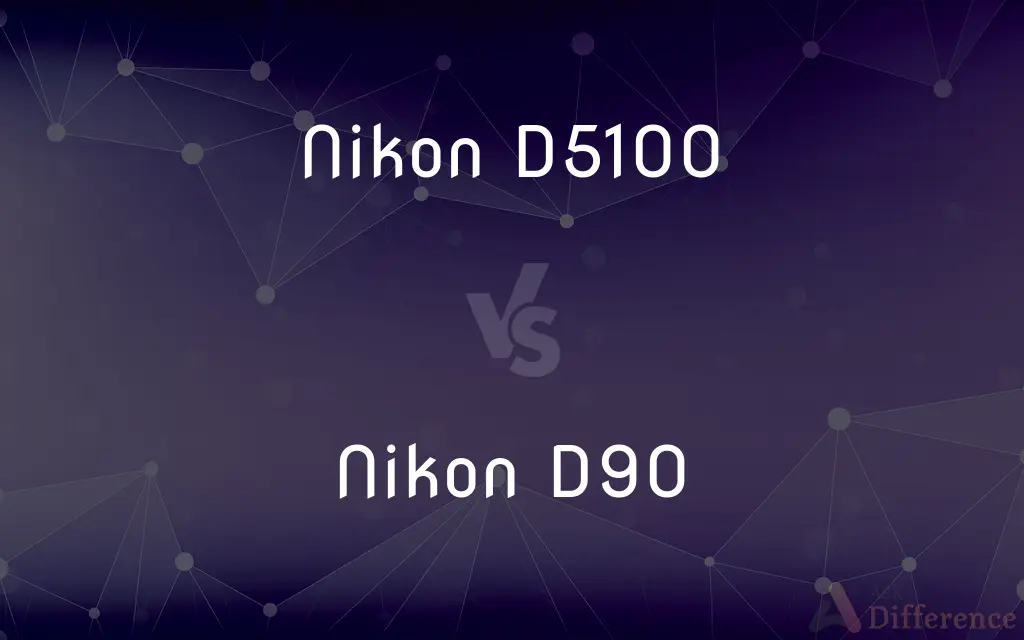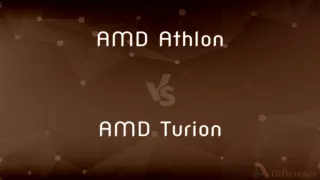Nikon D5100 vs. Nikon D90 — What's the Difference?
By Tayyaba Rehman & Urooj Arif — Published on February 13, 2024
Nikon D5100 is a mid-range DSLR with a 16.2 MP sensor, articulated screen, and HD video. Nikon D90 is an older, semi-professional DSLR with a 12.3 MP sensor and the first to offer HD video.

Difference Between Nikon D5100 and Nikon D90
Table of Contents
ADVERTISEMENT
Key Differences
The Nikon D5100 and Nikon D90 are both DSLR cameras from Nikon, designed for different levels of photography enthusiasts. The Nikon D5100, released in 2011, is aimed at advanced amateurs with its 16.2-megapixel sensor, offering higher resolution images compared to the Nikon D90's 12.3-megapixel sensor from 2008. The D5100's improved sensor technology provides better image quality, especially in low light conditions.
One of the notable differences between the Nikon D5100 and the Nikon D90 is the video capability. The D5100 offers full HD 1080p video recording, a step up from the D90's pioneering but more limited 720p HD video recording. This makes the D5100 a more attractive option for those interested in both photography and videography, offering better video quality and more modern features.
The Nikon D5100 features an articulated LCD screen, allowing for more flexible shooting angles and making it easier to compose shots in difficult positions. The Nikon D90, meanwhile, has a fixed screen, which can limit compositional versatility. The articulated screen of the D5100 is particularly useful for video recording and live view photography.
Ergonomically, the Nikon D90 is designed with a more robust body and offers a slightly better build quality, aimed at semi-professional users. It also provides more direct access controls for settings, appealing to experienced photographers who prefer manual adjustments over menu-driven interfaces. The D5100, while still offering manual controls, relies more on menu navigation, making it more accessible to beginners and advanced amateurs.
While the Nikon D90 was a groundbreaking camera in its time, especially as the first DSLR to introduce video recording, the Nikon D5100 represents a leap forward in terms of sensor technology, video capability, and user interface. The choice between them largely depends on the user's preference for image quality and modern features versus build quality and direct control.
ADVERTISEMENT
Comparison Chart
Sensor Resolution
16.2 megapixels
12.3 megapixels
Video Resolution
1080p HD
720p HD
LCD Screen
Articulated, 3-inch
Fixed, 3-inch
ISO Range
100-6400 (expandable to 25600)
200-3200 (expandable to 6400)
Release Date
2011
2008
Autofocus Points
11 points
11 points
Build Quality
More consumer-oriented
More robust, semi-pro oriented
Battery Life
Approximately 660 shots per charge
Approximately 850 shots per charge
Weight
560g (body only)
620g (body only)
Compare with Definitions
Nikon D5100
Known for its user-friendly interface and creative effects.
The Nikon D5100's creative effects inspire my photography projects.
Nikon D90
Features an ISO range of 200-3200, expandable to 6400.
Low-light photography is manageable with my Nikon D90's ISO range.
Nikon D5100
A mid-range DSLR with a 16.2 MP sensor and articulated screen.
I used my Nikon D5100 to capture stunning landscapes with ease, thanks to its swivel screen.
Nikon D90
A semi-professional DSLR with a 12.3 MP sensor.
My Nikon D90 has been my reliable companion for capturing sharp, detailed photos.
Nikon D5100
Features an ISO range of 100-6400, expandable to 25600.
Shooting in low light with the Nikon D5100 is a breeze due to its high ISO capabilities.
Nikon D90
The first DSLR to introduce HD video recording.
I started experimenting with HD video thanks to my Nikon D90.
Nikon D5100
Targets advanced amateurs with its balance of performance and ease of use.
Transitioning to DSLR photography was smooth with the Nikon D5100.
Nikon D90
Offers a robust build quality suited for semi-professional use.
The Nikon D90's durability has withstood countless photography trips.
Nikon D5100
Offers full HD 1080p video recording.
Filming documentaries with the Nikon D5100 has significantly improved my video quality.
Nikon D90
Designed with direct access controls for efficient setting adjustments.
Adjusting settings on the fly with the Nikon D90's controls saves me time during shoots.
Common Curiosities
Is the Nikon D90 more professionally oriented than the Nikon D5100?
Yes, with its robust build and direct access controls.
Which camera has a higher ISO capability?
The Nikon D5100 with an expandable range up to 25600.
Does the Nikon D5100 have a better screen than the Nikon D90?
Yes, the D5100 has an articulated screen, offering more flexibility.
What main advantage does the Nikon D5100 have over the Nikon D90?
Higher resolution sensor and full HD video recording.
Which camera offers more creative effects or modes?
The Nikon D5100 offers more creative effects and user-friendly modes.
Can the Nikon D90 record video?
Yes, it can record 720p HD video.
Do both cameras have the same number of autofocus points?
Yes, both have 11 autofocus points.
Which camera was released more recently?
The Nikon D5100 was released in 2011, after the Nikon D90.
How do the battery lives of the Nikon D5100 and D90 compare?
The D90 has a longer battery life, with up to 850 shots per charge.
Which camera is lighter, the Nikon D5100 or the Nikon D90?
The Nikon D5100 is lighter at 560g.
Can I use my old Nikon lenses with both the D5100 and D90?
Yes, both cameras are compatible with a wide range of Nikon F-mount lenses.
Can I shoot in RAW with both the Nikon D5100 and D90?
Yes, both cameras support RAW format shooting.
Are both cameras suitable for beginners?
The Nikon D5100 is more beginner-friendly, while the D90 may require some photography knowledge for best use.
Does either camera have built-in WiFi?
No, neither the D5100 nor the D90 has built-in WiFi.
What type of photography are each of these cameras best suited for?
The D5100 is great for advanced amateurs, while the D90 suits semi-professional needs.
Share Your Discovery

Previous Comparison
Jon Stewart vs. Stephen Colbert
Next Comparison
AMD Athlon vs. AMD TurionAuthor Spotlight
Written by
Tayyaba RehmanTayyaba Rehman is a distinguished writer, currently serving as a primary contributor to askdifference.com. As a researcher in semantics and etymology, Tayyaba's passion for the complexity of languages and their distinctions has found a perfect home on the platform. Tayyaba delves into the intricacies of language, distinguishing between commonly confused words and phrases, thereby providing clarity for readers worldwide.
Co-written by
Urooj ArifUrooj is a skilled content writer at Ask Difference, known for her exceptional ability to simplify complex topics into engaging and informative content. With a passion for research and a flair for clear, concise writing, she consistently delivers articles that resonate with our diverse audience.
















































